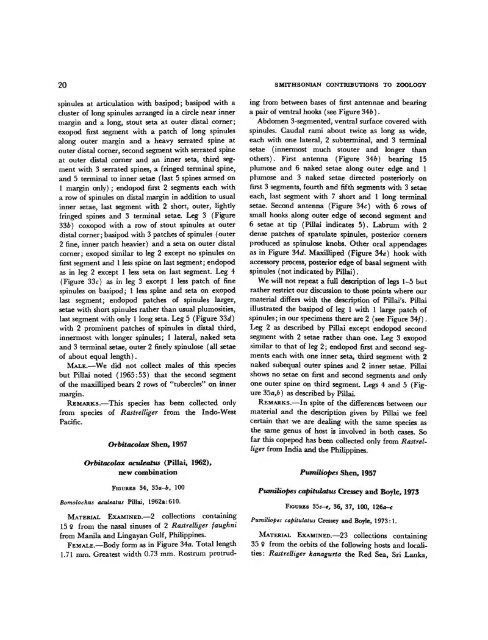Parasitic Copepods of Mackerel - and Tuna-like Fishes (Scombridae ...
Parasitic Copepods of Mackerel - and Tuna-like Fishes (Scombridae ...
Parasitic Copepods of Mackerel - and Tuna-like Fishes (Scombridae ...
Create successful ePaper yourself
Turn your PDF publications into a flip-book with our unique Google optimized e-Paper software.
20<br />
spinules at articulation with basipod; basipod with a<br />
cluster <strong>of</strong> long spinules arranged in a circle near inner<br />
margin <strong>and</strong> a long, stout seta at outer distal corner;<br />
exopod first segment with a patch <strong>of</strong> long spinules<br />
along outer margin <strong>and</strong> a heavy serrated spine at<br />
outer distal corner, second segment with serrated spine<br />
at outer distal corner <strong>and</strong> an inner seta, third segment<br />
with 3 serrated spines, a fringed terminal spine,<br />
<strong>and</strong> 5 terminal to inner setae (last 5 spines armed on<br />
1 margin only) ; endopod first 2 segments each with<br />
a row <strong>of</strong> spinules on distal margin in addition to usual<br />
inner setae, last segment with 2 short, outer, lightly<br />
fringed spines <strong>and</strong> 3 terminal setae. Leg 3 (Figure<br />
336) coxopod with a row <strong>of</strong> stout spinules at outer<br />
distal corner; basipod with 3 patches <strong>of</strong> spinules (outer<br />
2 fine, inner patch heavier) <strong>and</strong> a seta on outer distal<br />
corner; exopod similar to leg 2 except no spinules on<br />
first segment <strong>and</strong> 1 less spine on last segment; endopod<br />
as in leg 2 except 1 less seta on last segment. Leg 4<br />
(Figure 33c) as in leg 3 except 1 less patch <strong>of</strong> fine<br />
spinules on basipod; 1 less spine <strong>and</strong> seta on exopod<br />
last segment; endopod patches <strong>of</strong> spinules larger,<br />
setae with short spinules rather than usual plumosities,<br />
last segment with only 1 long seta. Leg 5 (Figure 33d)<br />
with 2 prominent patches <strong>of</strong> spinules in distal third,<br />
innermost with longer spinules; 1 lateral, naked seta<br />
<strong>and</strong> 3 terminal setae, outer 2 finely spinulose (all setae<br />
<strong>of</strong> about equal length).<br />
MALE.—We did not collect males <strong>of</strong> this species<br />
but Pillai noted (1965:53) that the second segment<br />
<strong>of</strong> the maxilliped bears 2 rows <strong>of</strong> "tubercles" on inner<br />
margin.<br />
REMARKS.—This species has been collected only<br />
from species <strong>of</strong> Rastrelliger from the Indo-West<br />
Pacific.<br />
Orbitacolax Shen, 1957<br />
Orbitacolax aculeatus (Pillai, 1962),<br />
new combination<br />
FIGURES 34, 35a-b, 100<br />
Bomolochus aculeatus Pillai, 1962a: 610.<br />
MATERIAL EXAMINED.—2 collections containing<br />
15 9 from the nasal sinuses <strong>of</strong> 2 Rastrelliger faughni<br />
from Manila <strong>and</strong> Lingayan Gulf, Philippines.<br />
FEMALE.—Body form as in Figure 34a. Total length<br />
1.71 mm. Greatest width 0.73 mm. Rostrum protrud-<br />
SMITHSONIAN CONTRIBUTIONS TO ZOOLOGY<br />
ing from between bases <strong>of</strong> first antennae <strong>and</strong> bearing<br />
a pair <strong>of</strong> ventral hooks (see Figure 346).<br />
Abdomen 3-segmented, ventral surface covered with<br />
spinules. Caudal rami about twice as long as wide,<br />
each with one lateral, 2 subterminal, <strong>and</strong> 3 terminal<br />
setae (innermost much stouter <strong>and</strong> longer than<br />
others). First antenna (Figure 346) bearing 15<br />
plumose <strong>and</strong> 6 naked setae along outer edge <strong>and</strong> 1<br />
plumose <strong>and</strong> 3 naked setae directed posteriorly on<br />
first 3 segments, fourth <strong>and</strong> fifth segments with 3 setae<br />
each, last segment with 7 short <strong>and</strong> 1 long terminal<br />
setae. Second antenna (Figure 34c) with 6 rows <strong>of</strong><br />
small hooks along outer edge <strong>of</strong> second segment <strong>and</strong><br />
6 setae at tip (Pillai indicates 5). Labrum with 2<br />
dense patches <strong>of</strong> spatulate spinules, posterior corners<br />
produced as spinulose knobs. Other oral appendages<br />
as in Figure 34d. Maxilliped (Figure 34e) hook with<br />
accessory process, posterior edge <strong>of</strong> basal segment with<br />
spinules (not indicated by Pillai).<br />
We will not repeat a full description <strong>of</strong> legs 1-5 but<br />
rather restrict our discussion to those points where our<br />
material differs with the description <strong>of</strong> Pillai's. Pillai<br />
illustrated the basipod <strong>of</strong> leg 1 with 1 large patch <strong>of</strong><br />
spinules; in our specimens there are 2 (see Figure 34/).<br />
Leg 2 as described by Pillai except endopod second<br />
segment with 2 setae rather than one. Leg 3 exopod<br />
similar to that <strong>of</strong> leg 2; endopod first <strong>and</strong> second segments<br />
each with one inner seta, third segment with 2<br />
naked subequal outer spines <strong>and</strong> 2 inner setae. Pillai<br />
shows no setae on first <strong>and</strong> second segments <strong>and</strong> only<br />
one outer spine on third segment. Legs 4 <strong>and</strong> 5 (Figure<br />
35a,6) as described by Pillai.<br />
REMARKS.—In spite <strong>of</strong> the differences between our<br />
material <strong>and</strong> the description given by Pillai we feel<br />
certain that we are dealing with the same species as<br />
the same genus <strong>of</strong> host is involved in both cases. So<br />
far this copepod has been collected only from Rastrelliger<br />
from India <strong>and</strong> the Philippines.<br />
Pumiliopes Shen, 1957<br />
Pumiliopes capitulatus Cressey <strong>and</strong> Boyle, 1973<br />
FIGURES 35c-e, 36, 37, 100, 126a-c<br />
Pumiliopes capitulatus Cressey <strong>and</strong> Boyle, 1973:1.<br />
MATERIAL EXAMINED.—23 collections containing<br />
35 5 from the orbits <strong>of</strong> the following hosts <strong>and</strong> localities:<br />
Rastrelliger kanagurta the Red Sea, Sri Lanka,

















